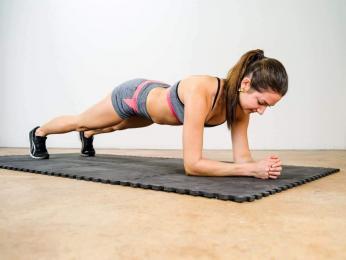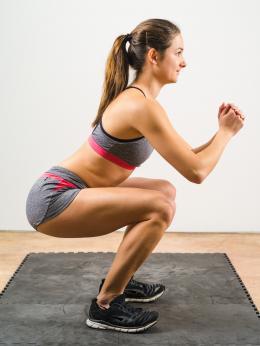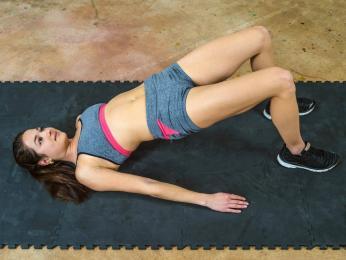Shopping Cart
There are no more items in your cart
If you want to incorporate workouts into your fitness routine that test your strength and also help you gain endurance and muscle mass, you should do isometric exercises to complement a balanced body workout.
But first, let's start by answering: What are isometric exercises? These are a form of static muscle contraction. When these exercises are performed, the length of the muscle and the joint angle do not change, but the strength of the contraction can vary significantly.
Isometric exercises are a training method for isometric strength, which can also be called "resistance," where the joint angle and muscle length remain constant. Additionally, this type of exercise is always done statically and never dynamically, which is why many of them are also used in medical rehabilitation therapies.  - Side plank: It is the same as the previous exercise but laterally, that is, on the forearms or hands we rotate the hips to one side, supporting ourselves with the outer edge of the foot. We keep the hips aligned with the rest of the body, separating the shoulders from the ears and contracting the abdomen. Similarly, we maintain the posture for 30 seconds and then gradually increase the time. - Isometric squat: It is an isometric exercise that should not be missing from your physical training routine. Lean against a wall to have better balance. The quadriceps will exert the force, supporting the weight of the body.
Once you place your back against the wall and your feet shoulder-width apart, slowly bend your knees as you lower your torso until your thighs are perfectly parallel to the ground. Make sure your feet are firmly planted on the ground. Maintain this position for 30 seconds, then gradually increase the time as you build your strength.
- Side plank: It is the same as the previous exercise but laterally, that is, on the forearms or hands we rotate the hips to one side, supporting ourselves with the outer edge of the foot. We keep the hips aligned with the rest of the body, separating the shoulders from the ears and contracting the abdomen. Similarly, we maintain the posture for 30 seconds and then gradually increase the time. - Isometric squat: It is an isometric exercise that should not be missing from your physical training routine. Lean against a wall to have better balance. The quadriceps will exert the force, supporting the weight of the body.
Once you place your back against the wall and your feet shoulder-width apart, slowly bend your knees as you lower your torso until your thighs are perfectly parallel to the ground. Make sure your feet are firmly planted on the ground. Maintain this position for 30 seconds, then gradually increase the time as you build your strength.  -Superman: Also called "back extension", it is an isometric exercise that allows us to work and strengthen the lower part of the back. We must lie face down on the floor, with our hands resting on the floor above our head. We start by performing a back extension, lifting the chest, hands, and legs off the floor, holding this position for 20 seconds, then resting for 10 seconds, and repeating in sets of 8 repetitions. - Isometric flexion: This isometric exercise will allow you to work your chest area very efficiently, in addition to gaining strength in your arms. They are performed like conventional push-ups but with the difference of static play, that is, isometric tension. Therefore, you must hold the position halfway through the movement by tensing the muscles involved, working only with your body weight. Glute bridge: It consists of an effective isometric exercise to work the glutes and hamstrings. To do it, lie down on the floor face up, bend your knees with your feet flat on the floor, and let your arms rest at your sides.
The exercise involves lifting the pelvis, creating a straight line from the knees to the neck.
-Superman: Also called "back extension", it is an isometric exercise that allows us to work and strengthen the lower part of the back. We must lie face down on the floor, with our hands resting on the floor above our head. We start by performing a back extension, lifting the chest, hands, and legs off the floor, holding this position for 20 seconds, then resting for 10 seconds, and repeating in sets of 8 repetitions. - Isometric flexion: This isometric exercise will allow you to work your chest area very efficiently, in addition to gaining strength in your arms. They are performed like conventional push-ups but with the difference of static play, that is, isometric tension. Therefore, you must hold the position halfway through the movement by tensing the muscles involved, working only with your body weight. Glute bridge: It consists of an effective isometric exercise to work the glutes and hamstrings. To do it, lie down on the floor face up, bend your knees with your feet flat on the floor, and let your arms rest at your sides.
The exercise involves lifting the pelvis, creating a straight line from the knees to the neck.  Your body should remain perfectly aligned from head to toe and your hands should be shoulder-width apart, with elbows bent and forearms perpendicular to the ground. Hold this position for 30 seconds and then rest to repeat in sets of 8 repetitions. - Shoulder elevation: You can do it with light weights or dumbbells, stand up and raise your arms laterally to shoulder height, hold that position for 20 or 30 seconds and then lower them to rest.
Go ahead and incorporate these exercises into your training routine!
Your body should remain perfectly aligned from head to toe and your hands should be shoulder-width apart, with elbows bent and forearms perpendicular to the ground. Hold this position for 30 seconds and then rest to repeat in sets of 8 repetitions. - Shoulder elevation: You can do it with light weights or dumbbells, stand up and raise your arms laterally to shoulder height, hold that position for 20 or 30 seconds and then lower them to rest.
Go ahead and incorporate these exercises into your training routine!
Benefits of isometric exercises
Fans of weightlifting and calisthenics believe that in strength development, the effectiveness of training with a load greater than their capacity is higher than that achieved through concentric exercises. Some of the main benefits of isometric exercises are:- They increase metabolic stress.
- They are done with the own body without the need for additional equipment.
- They improve strength in a specific joint range.
- Very frequently used in injury rehabilitation.
- They increase muscle mass and physical endurance.
Isometric exercises, which ones to do?
Below we will show you the main isometric exercises that you can do from the comfort of your home, if you wish, or anywhere else you prefer. The important thing is that you feel comfortable and can dedicate time to doing them. -Iron: This is a basic isometric exercise. You should lie face down on the floor with your body completely straight, simulating a plank. Your toes and elbows or forearms will be the support. Your gaze should be towards the ground and you must hold the straight posture without arching your lower back while engaging your abdomen. Start by holding this position for 30 seconds and then gradually increase the time. - Side plank: It is the same as the previous exercise but laterally, that is, on the forearms or hands we rotate the hips to one side, supporting ourselves with the outer edge of the foot. We keep the hips aligned with the rest of the body, separating the shoulders from the ears and contracting the abdomen. Similarly, we maintain the posture for 30 seconds and then gradually increase the time. - Isometric squat: It is an isometric exercise that should not be missing from your physical training routine. Lean against a wall to have better balance. The quadriceps will exert the force, supporting the weight of the body.
Once you place your back against the wall and your feet shoulder-width apart, slowly bend your knees as you lower your torso until your thighs are perfectly parallel to the ground. Make sure your feet are firmly planted on the ground. Maintain this position for 30 seconds, then gradually increase the time as you build your strength.
- Side plank: It is the same as the previous exercise but laterally, that is, on the forearms or hands we rotate the hips to one side, supporting ourselves with the outer edge of the foot. We keep the hips aligned with the rest of the body, separating the shoulders from the ears and contracting the abdomen. Similarly, we maintain the posture for 30 seconds and then gradually increase the time. - Isometric squat: It is an isometric exercise that should not be missing from your physical training routine. Lean against a wall to have better balance. The quadriceps will exert the force, supporting the weight of the body.
Once you place your back against the wall and your feet shoulder-width apart, slowly bend your knees as you lower your torso until your thighs are perfectly parallel to the ground. Make sure your feet are firmly planted on the ground. Maintain this position for 30 seconds, then gradually increase the time as you build your strength.  -Superman: Also called "back extension", it is an isometric exercise that allows us to work and strengthen the lower part of the back. We must lie face down on the floor, with our hands resting on the floor above our head. We start by performing a back extension, lifting the chest, hands, and legs off the floor, holding this position for 20 seconds, then resting for 10 seconds, and repeating in sets of 8 repetitions. - Isometric flexion: This isometric exercise will allow you to work your chest area very efficiently, in addition to gaining strength in your arms. They are performed like conventional push-ups but with the difference of static play, that is, isometric tension. Therefore, you must hold the position halfway through the movement by tensing the muscles involved, working only with your body weight. Glute bridge: It consists of an effective isometric exercise to work the glutes and hamstrings. To do it, lie down on the floor face up, bend your knees with your feet flat on the floor, and let your arms rest at your sides.
The exercise involves lifting the pelvis, creating a straight line from the knees to the neck.
-Superman: Also called "back extension", it is an isometric exercise that allows us to work and strengthen the lower part of the back. We must lie face down on the floor, with our hands resting on the floor above our head. We start by performing a back extension, lifting the chest, hands, and legs off the floor, holding this position for 20 seconds, then resting for 10 seconds, and repeating in sets of 8 repetitions. - Isometric flexion: This isometric exercise will allow you to work your chest area very efficiently, in addition to gaining strength in your arms. They are performed like conventional push-ups but with the difference of static play, that is, isometric tension. Therefore, you must hold the position halfway through the movement by tensing the muscles involved, working only with your body weight. Glute bridge: It consists of an effective isometric exercise to work the glutes and hamstrings. To do it, lie down on the floor face up, bend your knees with your feet flat on the floor, and let your arms rest at your sides.
The exercise involves lifting the pelvis, creating a straight line from the knees to the neck.  Your body should remain perfectly aligned from head to toe and your hands should be shoulder-width apart, with elbows bent and forearms perpendicular to the ground. Hold this position for 30 seconds and then rest to repeat in sets of 8 repetitions. - Shoulder elevation: You can do it with light weights or dumbbells, stand up and raise your arms laterally to shoulder height, hold that position for 20 or 30 seconds and then lower them to rest.
Go ahead and incorporate these exercises into your training routine!
Your body should remain perfectly aligned from head to toe and your hands should be shoulder-width apart, with elbows bent and forearms perpendicular to the ground. Hold this position for 30 seconds and then rest to repeat in sets of 8 repetitions. - Shoulder elevation: You can do it with light weights or dumbbells, stand up and raise your arms laterally to shoulder height, hold that position for 20 or 30 seconds and then lower them to rest.
Go ahead and incorporate these exercises into your training routine!